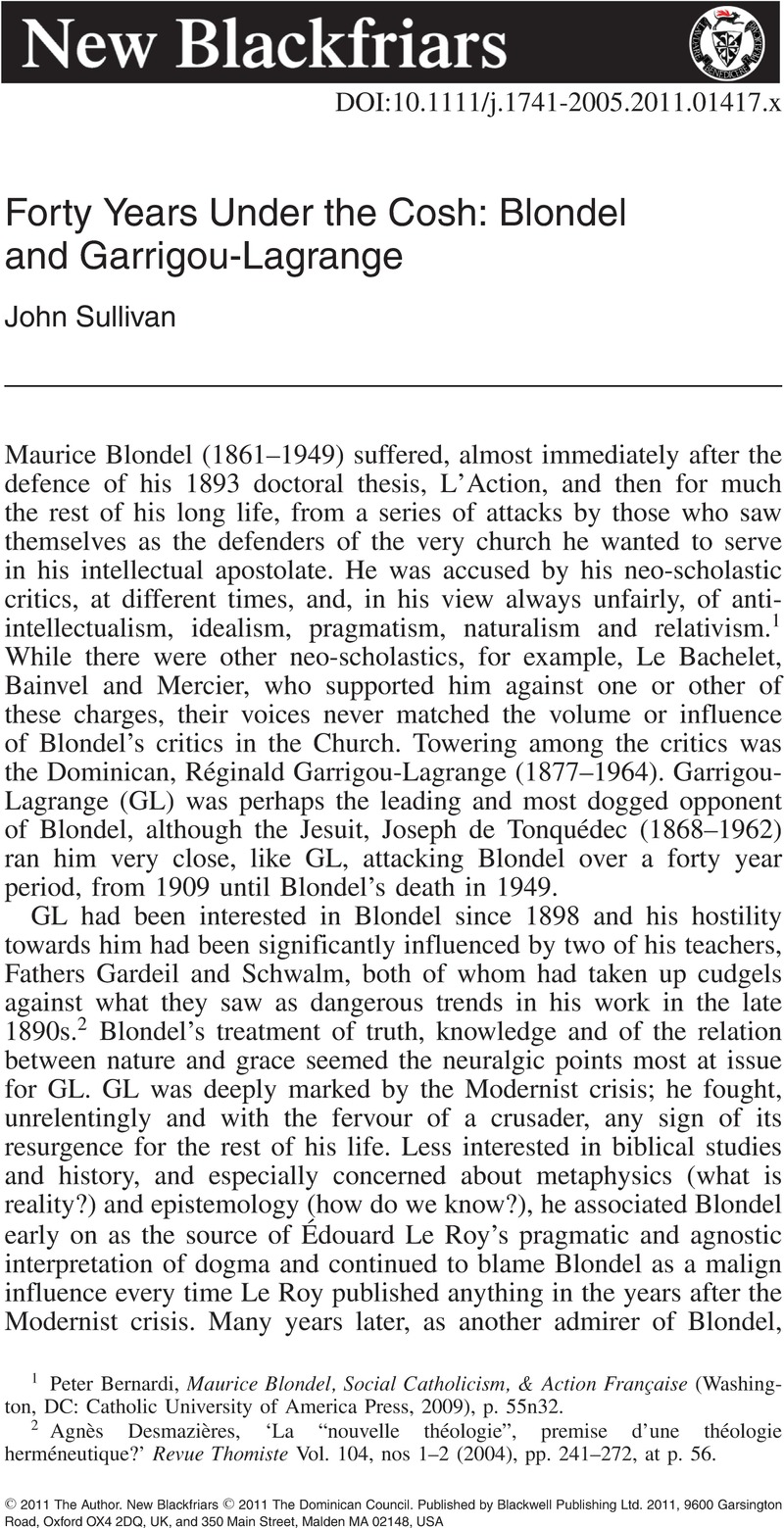Article contents
Forty Years Under the Cosh: Blondel and Garrigou-Lagrange
Published online by Cambridge University Press: 01 January 2024
Abstract

- Type
- Original Articles
- Information
- Copyright
- © 2011 The Author. New Blackfriars © 2011 The Dominican Council
References
1 Bernardi, Peter, Maurice Blondel, Social Catholicism, & Action Française (Washington, DC: Catholic University of America Press, 2009), p. 55n32Google Scholar.
2 Desmazières, Agnès, ‘La “nouvelle théologie”, premise d’une théologie herméneutique?’Revue Thomiste Vol. 104, nos 1–2 (2004), pp. 241–272, at p. 56Google Scholar.
3 Coffele, Gianfranco, Apologetica e Teologia Fondamentale (Rome: Edizioni Studium), 2004, p. 200Google Scholar.
4 Mansini, Guy, “What is a Dogma?” The Meaning and Truth of Dogma in Edouard Le Roy and his Scholastic Opponents (Rome: Editrice Pontificia Universita Gregoriana, 1985), p. 74Google Scholar.
5 GL, quoted by Kerlin, Michael, ‘Anti-Modernism and the elective affinity between politics and philosophy’ in Catholicism Contending with Modernity, edited by Jodock, Darrell, (Cambridge: Cambridge University Press, 2000), pp. 315–16Google Scholar.
6 Mansini, p. 92.
7 Ibid., p. 330.
8 Lonergan, Bernard, Method in Theology (London: Darton, Longman & Todd, 1973Google Scholar), p. 113.
9 Mansini, p. 346.
10 See Blondel, Maurice, Une alliance contre nature: catholicisme et intégrisme (Bruxelles: Editions Lessius, 2000Google Scholar).
11 Mansini, p. 373.
12 Tourpe, Emmanuel, ‘Blondel et le Thomisme’ in Blondel entre L’Action et la Trilogie, edited by Leclerc, Marc (Bruxelles: Editions Lessius, 2003), pp. 52–65Google Scholar, at p. 57.
13 Undated letter from GL to Blondel, in Coffele, p. 214.
14 Bouillard, Henri, Vérité du Christianisme (Paris: Désclée de Brouwer, 1989), p. 78Google Scholar.
15 Coffele, p. 215.
16 Bouillard, p. 77.
17 Ibid.
18 Coffele, p. 198.
19 Bernardi. See note 1.
20 Laberthonnière, , Positivisme et catholicisme: à propos de ‘l’Action Française, (Paris: Bloud et Cie, 1911)Google Scholar.
21 Peddicord, Richard, The Sacred Monster of Thomism (South Bend, Indiana: St Augustine's Press, 2005)Google Scholar; Nichols, Aidan, Reason with Piety (Naples, FL: Sapientia Press, 2008)Google Scholar.
22 Nichols, pp. 26, 34.
23 Peddicord, p. 76.
24 Ibid., p. 222.
25 Ibid., p. 172.
26 Peddicord, p. 62.
27 Ibid., p. 63.
28 Ibid., p. 64.
29 Ibid., p. 74.
30 Ibid., p. 65.
31 Coffele, p. 234.
32 Coffele, p. 235.
33 Blondel, , La Pensée, I (Paris: Presses Universitaires de France, 4th edition, 1948), pp. 237–240Google Scholar.
34 GL, quoted by Kerlin, , ‘Reginald Garrigou-Lagrange: Defending the Faith’US Catholic Historian 25 (1), 2007, pp. 97–113 at p. 107CrossRefGoogle Scholar.
35 Coffele, p. 246.
36 Ibid., p. 253.
37 Ibid., p. 254.
38 See Blondel, , Carnets Intimes, I, (Paris: Cerf, 1961), p. 195Google Scholar.
39 Blondel-Valensin, , Correspondance III, 1912–1947 (Paris: Aubier, 1965), p. 227Google Scholar.
40 Ibid.
41 Coffele, p. 207.
42 See message from JP II at start of Blondel entre L’Action et la Trilogie, p. 5.
43 Tourpe, Emmanuel, ‘Blondel et le Thomisme’, in Maurice Blondel et la Philosophie Française edited by Gabellieri, Emmanuel and Cointet, Pierre de (Paris: Parole et Silence, 2007), pp. 223–237Google Scholar.
44 Ibid., p. 235.
45 Ibid., p. 236. See also Tourpe's chapter in Blondel entre L’Action et la trilogie– note 12, supra.
46 As one example, see Rziha, John, Perfecting Human Actions (Washington, DC: Catholic University of America Press, 2009)Google Scholar.
47 Kerlin, ‘Reginald Garrigou-Lagrange: Defending the Faith’, p. 112, footnote 45.
48 GL, quoted in Mansini, p. 316.
- 2
- Cited by


